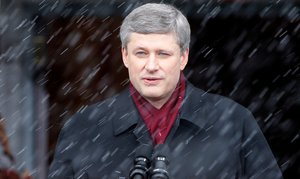Harpering on Harper: Canada, 2015
Harper is a master tactician. Knowing that there is a block of rightwing voters who have nowhere else to go, he has been willing to defy them in search of wider support: adopting liberal positions on abortion and gay marriage; veering leftwards to pump public money into the economy to avoid recession in 2008; reaching out to the migrants who now fill the suburbs of traditionally Liberal cities such as Toronto. He studies the stats. He makes the numbers add up. Harper has his roots in the same ideological soil as Thatcher and Reagan: cutting tax and rolling back the state; tough on crime and even tougher on the unions; boosting families and national pride; a solid economy that rewards those who work hard.
Harper has his roots in the same ideological soil as Thatcher and Reagan: cutting tax and rolling back the state
And then there were the tactics that were to attract such notoriety. They reflected the man's character - clever and harsh - moves that turned a democratic election into a mere sequence of manoeuvres. He learned from the master, Arthur Finkelstein, who had played the electoral game for Richard Nixon and Ronald Reagan. One of Harper's early allies from the 1990s, Gerry Nicholls, captured in his memoirs the special cynicism of Finkelstein's will to manipulate the electorate in his dictum: "We have to convince Canadians to drink pig's piss."
-- Nick Davies
And it meant investing heavily in the politically profitable new science of microtargeting. This was the original reason for the Conservatives creating the Cims database, in which was stored every conceivable item of intelligence about voters. Other parties have since caught up, but at that time it allowed the Conservative party to target the "market segments" it needed for victory - not just with policy, but with favours. A $500 tax break for children to do ballet or hockey in the 2006 budget was good for a middle-class segment (this was doubled in 2014). A break for tradespeople's tools could buy another. The Canadian writer Susan Delacourt, who tracked this in her book, Shopping For Votes, told of the finding in the Cims database that people who owned snowmobiles were potential Conservative voters. The Harper government has pledged $35m to create new trails for snowmobiles.
These tactics have proved particularly effective in a world in which people are becoming alienated from politics itself. In Canada, nearly 40% of the electorate did not bother to vote at the 2011 election. Among voters under 24, more than 60% stayed away (compared with 35.3% in 2006). A poll in Quebec province two months ago found that as the federal election campaign was launched, 20% of respondents could not name the political party that was running the country. Delacourt cites one of Harper's political marketers, Patrick Muttart, saying that much of Conservative activity was aimed at voters who paid no attention to politics and who needed messages that were "brutally simple".
